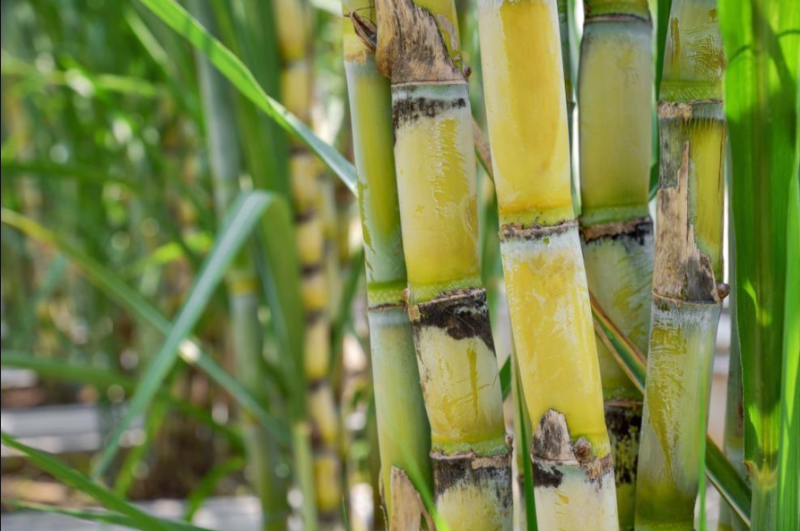The sugar cane plant, scientifically known as Saccharum officinarum, is a tall perennial grass celebrated for its sweet sap-rich stems. Not only is it an essential crop for producing sugar and molasses, but it also serves decorative purposes in home gardens, offering privacy and aesthetic appeal.
This comprehensive guide will delve into the care requirements, growing conditions, and maintenance tips to help you successfully cultivate your own sugar cane plants.
Understanding Sugar Cane

Sugar cane is a robust, clump-forming grass that can reach heights of 5 to 10 feet and widths of 5 to 8 feet. It thrives in warm, humid climates, making it suitable for USDA hardiness zones 9 to 10. While it is native to Asia, sugar cane has been adopted worldwide for its versatility. It flourishes in full sun and prefers well-drained, nutrient-rich soil with a pH between 6.0 and 6.5. When adequately cared for, sugar cane becomes a fast-growing, eye-catching addition to any garden.
Ideal Growing Conditions
Light Requirements
Sugar cane plants thrive best in full sun exposure, which is critical for their overall growth and sap production. For optimal development, aim to provide them with at least 6 to 8 hours of direct sunlight each day. This abundant light is essential not only for photosynthesis but also for the accumulation of sugars in the plant’s stems, which is the primary reason for its cultivation.
When planting sugar cane, consider the placement in your garden carefully. Avoid areas shaded by trees, fences, or other structures that may block sunlight during the day. The more sunlight the plants receive, the stronger and healthier they will become, leading to more vigorous growth and a higher yield of sweet sap.
In addition to sunlight, monitor the surrounding environment for potential obstructions that could hinder light access, especially as the seasons change. Providing consistent sunlight exposure will help ensure your sugar cane plants develop robust stalks, lush foliage, and the high sugar content that makes them so desirable, whether for culinary uses or ornamental purposes.
Soil Quality
Sugar cane is known for its adaptability to a range of soil types, but for optimal growth, it truly thrives in well-drained, deep soil that crumbles easily. The texture and drainage capacity of the soil play a significant role in the plant’s health and productivity. Ideally, the soil should be loamy, rich in organic matter, and capable of holding moisture while also allowing excess water to escape. This balance prevents issues like root rot, which can occur in overly saturated soils.
Before planting, it’s essential to amend the soil with organic matter, such as well-aged compost or well-rotted manure. These amendments not only enhance soil fertility but also improve its structure, promoting better aeration and moisture retention. A nutrient-rich environment is crucial, as sugar cane is a heavy feeder that requires significant amounts of nitrogen, phosphorus, and potassium to support its rapid growth and sugar accumulation.
Testing the soil pH is also advisable; sugar cane prefers a slightly acidic to neutral pH, ideally between 6.0 and 6.5. If the soil is too acidic or alkaline, consider adding lime to raise the pH or sulfur to lower it, ensuring an optimal growing environment. Additionally, regular applications of organic fertilizers throughout the growing season can help replenish the nutrients that sugar cane rapidly depletes from the soil, promoting healthy plants that yield an abundant harvest.
Watering Needs
Consistent moisture is vital for the health and productivity of sugar cane plants. These robust grasses thrive with a weekly irrigation schedule of approximately 1 to 2 inches of water, particularly during periods of low rainfall or dry spells. Proper watering not only promotes healthy growth but also aids in the accumulation of sugars within the stems, which is crucial for achieving high yields.
However, it’s important to be cautious about overwatering, as sugar cane is susceptible to root rot and other moisture-related issues when planted in soggy soil. Ensure that the soil drains well and does not remain waterlogged for extended periods. To achieve this, consider implementing a well-designed irrigation system that allows for adequate drainage while providing the necessary moisture.
If you plan to harvest mature sugar cane stems, it’s beneficial to allow the soil to dry out slightly as the harvest approaches. This technique encourages the plant to concentrate sugars in the lower stalks, enhancing the sweetness of the harvested canes. During this time, reduce your watering frequency and monitor the moisture levels closely, ensuring that the plants remain healthy while maximizing their sugar content.
Temperature and Humidity
Sugar cane thrives in warm, humid conditions, making it a perfect choice for tropical and subtropical climates. The ideal temperature for optimal growth hovers around 90°F (32°C), where the plant can reach its full potential in terms of height, vigor, and sugar production. Consistently warm temperatures enable the plant to undergo photosynthesis efficiently, contributing to robust growth and increased sap accumulation.
In addition to warmth, sugar cane requires a relative humidity of at least 50% to flourish. This level of humidity supports the plant’s physiological processes, helping to prevent stress and promoting healthy leaf development. If humidity levels drop too low, the plant may struggle to retain moisture, leading to slower growth and reduced yields.
It’s crucial to be aware that sugar cane is sensitive to cold weather; it cannot tolerate freezing temperatures. If the mercury dips below 70°F (21°C), growth may become stunted, hindering the plant’s overall development. In regions that experience cooler temperatures, consider implementing protective measures, such as mulching or using row covers during unexpected cold snaps, to safeguard your sugar cane plants.
Fertilization
When growing sugar cane as an edible crop, providing regular nutrition is essential for its growth and sap production. This plant is a heavy feeder, meaning it requires ample nutrients to thrive. It’s advisable to use a high-nitrogen fertilizer, applying it weekly throughout the summer growing season when the plant is actively growing. This frequent feeding helps ensure that sugar cane has the necessary nutrients to develop strong stems and lush foliage, ultimately leading to a sweeter harvest.
For those cultivating sugar cane for ornamental purposes, the fertilization approach can be adjusted. Instead of weekly applications, fertilize the plant three times during the growing season with a slow-release high-nitrogen fertilizer. This method is effective for maintaining the health and appearance of the plant without overwhelming it with nutrients.
To protect the plant’s roots from fertilizer burn, always apply the fertilizer at least 10 inches away from the base of the plant. This practice allows the roots to absorb nutrients without coming into direct contact with the fertilizer, minimizing the risk of damage.
Pruning Your Sugar Cane
Pruning is a crucial aspect of sugar cane care that helps maintain both the health and aesthetic appeal of the plant. As sugar cane can grow quite vigorously, it may begin to sprawl, losing its desirable upright form. In such cases, it’s beneficial to trim the plant back to restore its structure and encourage a more compact growth habit. Regularly assessing the plant’s shape and size will guide you on when to perform this maintenance.
In addition to shaping, it’s important to remove any dead or withered foliage. This not only enhances the visual appeal of your sugar cane but also improves air circulation, which can help prevent disease. A tidy appearance is important, especially if you’re using sugar cane as an ornamental feature in your garden.
Moreover, the stalks you cut can be repurposed in several beneficial ways. They can serve as organic mulch, helping to retain soil moisture and suppress weeds around the base of your sugar cane. Alternatively, these cuttings can be used to propagate new plants. Simply plant the cut stalks back in the soil to create new shoots, ensuring that your sugar cane garden continues to thrive.
Propagating Sugar Cane
Sugar cane is typically propagated using seed canes, but you can also use stem cuttings. Here’s a step-by-step guide for taking cuttings:
- Select a Healthy Stem: Using a sterilized gardening tool, cut a 4- to 6-inch piece of a healthy sugar cane stem that has at least two internodes.
- Planting the Cutting: Bury the cutting deep enough so that no more than 2 inches is above the soil. Alternatively, you can lay it horizontally in the soil.
- Watering and Growth: Keep the soil moist, and within two weeks, you should see shoots appearing from the nodes and roots developing.
Growing Sugar Cane from Seed
Although less common, it is possible to grow sugar cane from seeds. For best results:
- Timing: Sow seeds directly in the garden two weeks after the last frost when the soil temperature is at least 60°F (15°C).
- Depth and Spacing: Plant seeds 1 to 1.5 inches deep, spacing them 8 to 12 inches apart in rows 36 to 42 inches apart.
- Moisture Maintenance: Keep the soil consistently moist until the seeds germinate, which takes about 10 days. Once seedlings emerge, thin them to 8 to 12 inches apart.
Container Growing and Overwintering
If you live in a cooler climate, consider growing sugar cane in containers. Select a pot that is at least 14 inches deep and has ample drainage holes. Use a mixture of potting soil and compost. Here’s how to care for container-grown sugar cane:
- Watering: Container soil dries out faster, so adjust your watering schedule to keep it consistently moist.
- Repotting: When your plant becomes root-bound, repot it into a larger container with fresh soil.
- Winter Care: Bring container plants indoors before the first fall frost. For plants in the ground, cut them back and cover the stubble with soil to protect against cold.
Common Pests and Diseases
Sugar cane, while a robust and resilient plant, can fall victim to a variety of pests and diseases that threaten its health and productivity. Awareness and proactive management are essential to protect your crop and ensure optimal growth. Here’s a closer look at the common pests and diseases that can affect sugar cane, along with strategies for prevention and management.
Common Pests
- Mealybugs: These small, white, cottony insects feed on the sap of sugar cane plants, weakening them and potentially leading to stunted growth. They often leave behind a sticky residue that can attract other pests and encourage the growth of sooty mold.
- Moth Caterpillars: Caterpillars from various moth species can damage sugar cane by feeding on the leaves. Their presence may lead to significant defoliation, reducing the plant’s ability to photosynthesize and ultimately impacting sugar production.
- Sugar Cane Borers (Diatraea saccharalis): These notorious pests tunnel into the stalks of sugar cane, causing severe structural damage. Infestations can lead to weakened plants and increased susceptibility to diseases. They are particularly challenging to control once they have entered the plant.
- Termites: While they typically target decaying wood, termites can also infest sugar cane plants, especially those weakened by other pests or diseases. Their tunneling can compromise the integrity of the stalks.
- Spittlebugs: These small insects produce a frothy substance that can coat the plant, which can interfere with photosynthesis. They feed on the sap, causing yellowing leaves and stunted growth.
- Sugar Cane Beetles (Euetheola humilis): These beetles primarily feed on the foliage and can cause significant leaf damage, reducing the plant’s vigor. Their feeding can also create entry points for diseases.
Common Diseases
- Root Rot: Root rot is typically caused by overwatering and poorly drained soils, leading to fungal infections that compromise the root system. Symptoms include yellowing leaves and overall wilting of the plant. If left unchecked, it can lead to plant death.
- Whip Smut: This fungal disease manifests as galls on the plant’s leaves and stems, which can drastically reduce yield. It thrives in warm, humid conditions and is most common when the plants are under stress.
- Red Stripe (Top Rot): This disease is caused by a fungus that affects the leaves and can lead to significant yield loss. The symptoms include red stripes on the leaves, which eventually wilt and die. Management often requires crop rotation and the use of disease-resistant varieties.
- Viral Problems: Sugar cane can also be susceptible to various viral infections, which can cause stunted growth, yellowing, and overall decline in plant health. These viruses are often spread by aphids and other pests, making pest management a key component of disease prevention.
Prevention and Management
To effectively manage pests and diseases in your sugar cane crop, adopt good cultural practices and maintain regular monitoring. Here are some strategies:
- Regular Inspections: Frequently check your plants for any signs of pests or diseases. Early detection is key to preventing the spread and minimizing damage.
- Cultural Practices: Implement good cultural practices such as crop rotation, proper watering techniques, and maintaining optimal soil health to create an environment less conducive to pests and diseases.
- Natural Predators: Encourage beneficial insects, such as ladybugs and predatory wasps, that can help control pest populations.
- Organic Pesticides: If pest infestations become severe, consider using organic pesticides or insecticidal soaps that are less harmful to beneficial insects and the environment.
- Timely Interventions: Act quickly if you notice signs of disease. Isolate affected plants to prevent the spread and consult with agricultural extension services for appropriate treatment options.
Conclusion
Growing sugar cane can be a rewarding endeavor, whether for its sweet sap or as an ornamental feature in your garden. By understanding its care requirements—light, soil, water, temperature, and pest management—you can create the ideal environment for your sugar cane plants to thrive. Whether you’re planting for consumption or decorative purposes, following these top tips will help ensure your sugar cane flourishes, providing you with a beautiful and productive garden addition. Embrace the challenge and enjoy the journey of cultivating this remarkable plant!






